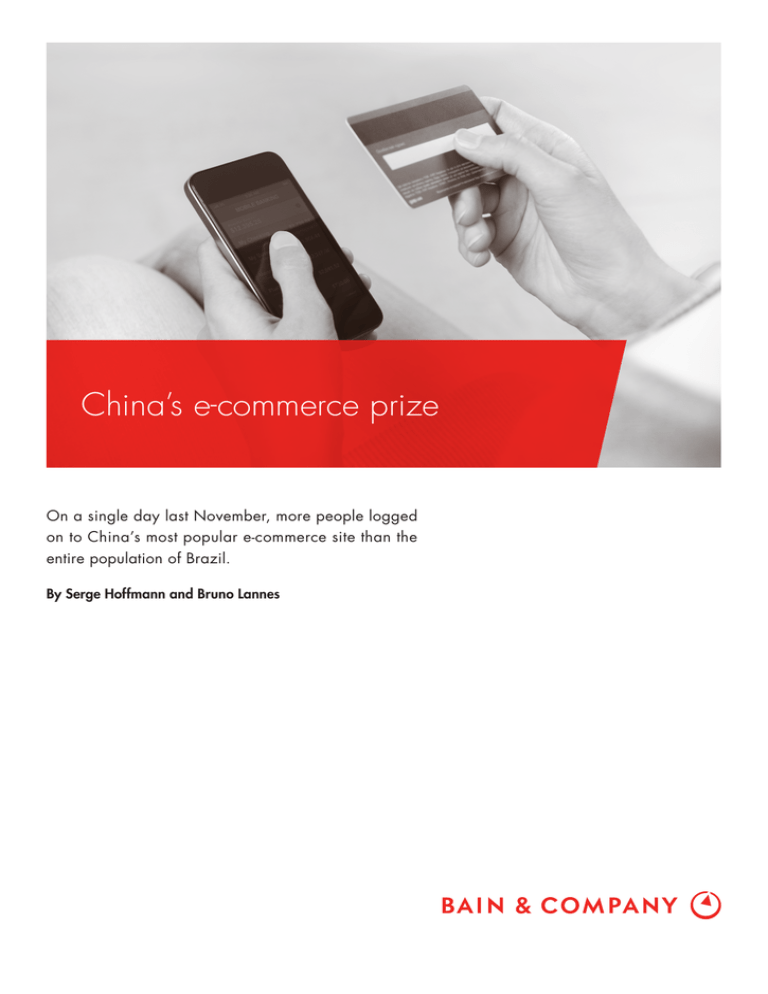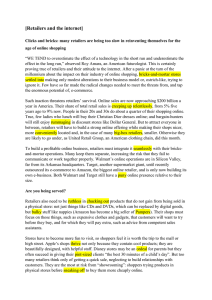
China’s e-commerce prize
On a single day last November, more people logged
on to China’s most popular e-commerce site than the
entire population of Brazil.
By Serge Hoffmann and Bruno Lannes
Serge Hoffmann is a Bain & Company partner based in Hong Kong, and
Bruno Lannes is a Bain & Company partner based in Shanghai. Both are
members of the firm’s Consumer Products and Retail practices.
The authors would like to acknowledge the contributions of consultants
Hongfei Zheng and Chen Chen and associate consultant Levix Liang in
Bain & Company’s Shanghai office.
Copyright © 2013 Bain & Company, Inc. All rights reserved.
China’s e-commerce prize
The year 2013 will be remembered as the one in which
China surpassed the US as the world’s largest digital
retail market. Last year, Chinese e-commerce shoppers
spent RMB 1.3 trillion online, a sum that has grown
more than 70% annually since 2009 and is expected
to continue on its amazing trajectory, reaching RMB
3.3 trillion by 2015 (see Figure 1). Digital retailing has
furiously transformed shopping and purchasing habits,
opening up vast opportunities for retailers and brands
that pay attention to the nuances of massively changing
consumer behavior.
shoppers have been more willing than shoppers in other
markets to use their smartphones to make purchases,
are comfortable with third-party payments and online
banking, and are happy to rely on third parties for deliveries—as opposed to picking up products in stores.
Perhaps most important for the years to come is that
we learned that digital retailing now is the major influence on their actual purchasing decisions.
In a surprising finding, more than half of those surveyed
say that, regardless of where they end up making the
purchase—online or in the physical store—they browse
websites and make price comparisons before they buy.
In fact, Chinese consumers spend much more time
browsing online before making a purchase than their
counterparts in other countries. More than 70% of
survey respondents from all income levels say they
often compare prices—online vs. offline and across
e-stores. Such distinctive behavior is reflected in the
quick popularity of Etao, a website that consolidates the
prices from different e-stores, allowing consumers to
To better understand how Chinese consumers shop and
purchase online—and what implications that has for
retailers and brands—Bain & Company surveyed more
than 1,300 online shoppers across all city tiers, incomes,
ages and education levels. A follow-up to our initial 2012
China e-commerce report, it gave us the opportunity to
dig deeper into the dramatic growth numbers to understand how the world of online retailing has changed
their behavior (see Figure 2) . We found Chinese
Figure 1: China is now the No. 1 digital retail market in value and penetration, with momentum that’s
expected to continue
China digital market: No. 1 and growing
Online retail value as % of total retail
Indexed market size of online shopping
(including USD depreciation)
12
China digital market: No. 1 digital penetration
Change of %
CAGR
CAGR
(09–12) (12–15F)
China
71%
10%
32%
5.8%
China’s total
4.3%
US
Germany
1.1%
1.8%
Japan
1.1%
Canada
0.4%
8
9
US
13%
13%
6
6
4
3
0
China’s
tier 1and tier 2
2
09
China online shopping
market size
(RMB trillions): 0.3
12
15F
1.3
3.3
0
2009
Sources: iResearch; China statistics bureau; US Department of Commerce; Euromonitor; Bain analysis
1
2010
2011
2012
China’s e-commerce prize
Figure 2: Chinese digital shoppers display unique characteristics
“Repertoire” quickly
ramps up online
“Smartphone animals”
“Bargain hunters”
• Chinese consumers like
to buy multiple brands
(see Bain’s 2012
China Shopper Reports)
• Chinese shoppers love sales
• They go down the
experience curve and
increase spending fast
• They like to—and actually
do—compare price among
multiple e-stores
• Price is stated as the No. 1
reason for going online
• Chinese consumers are
addicted to smartphones
• Smartphone penetration more
than 50% in tier-1and
tier-2 cities
Fan of overseas
purchase agency
• Chinese shoppers favor
overseas purchases mainly
due to health concerns and
price difference
• More than 50% of digital
shoppers browse via mobile
Source: Bain & Company; i-research; e-commerce related media researches
compare prices and then quickly navigate to the e-store
offering the best price. The benchmarking site generates
2.3 million unique viewers each day, more than three
times the volume of the website traffic for retailer Suning.
Until this year, the lion’s share of growth came from
increased sales from existing online shoppers. Over the
next three years, the bulk of new sales—58%—will come
from new consumers, according to our analysis. Digital
retail penetration in China already has leapfrogged
ahead of that of developed countries. When looked at
as a percentage of the total retail value, online retailing
in China totals 6% of all purchases, compared with 5%
in Germany and about 3.9% in Japan. While online
retailing has soared in China since 2009, it was relatively
flat in developed markets.
Nearly 70% of shoppers who bought online first went to
a physical store to see the product and make their selection, before returning to their computer or smartphone
to make the actual purchase. Because Chinese shoppers
move easily between physical stores and online options,
there’s no overlooking the fact that online sites support
brick-and-mortar store sales, and vice versa.
How China’s online shoppers are different
The wildfire-like adoption of digital retailing over the
past two years is staggering. Consider the phenomenal
growth in penetration for such categories as apparel,
cosmetics, consumer electronics and books. In just two
years, apparel penetration rose from a mere 1.6% to 13%
in value, according to estimates by iResearch. Cosmetics
rocketed from 2.5% to 11% and consumer electronics
from 4% to 17%. Digital penetration in the books category
grew from 4.5% in 2010 to 30% in 2012.
As they embrace digital retailing at an extraordinary pace,
Chinese shoppers’ unique characteristics are coming
into sharper focus, helping brands and retailers hone
their strategies. Our survey examined shopper behaviors
and views in eight product categories that have an established digital presence. We learned what motivates them
to shop online—and what keeps them away.
2
China’s e-commerce prize
Our current survey and prior Bain research highlight
the traits of Chinese consumers:
•
They are what we describe as “repertoire” shoppers.
Instead of showing exclusive loyalty to a single
brand, in most categories they tend to choose from
multiple brands for the same need or occasion. They
not only tend to buy multiple brands, but they also
buy from different e-commerce stores. (See the Bain
report “What Chinese shoppers really do but will
never tell you.”)
•
They are bargain hunters. In fact, half of those
surveyed say price is the No. 1 reason for going
online, where they compare prices among an array
of e-commerce sites as well as physical stores. On
average, they look at two to three websites prior to
making each purchase. They also are motivated by
promotions, whether or not the promotion actually
is the lowest price. Their determination to find the
best deal explains why Tmall’s annual sales event,
“11.11,” on each November 11, has become the largest digital retailing day of the year (see the sidebar,
“The Tmall phenomenon”). In 2012, the sales event
lured 213 million shoppers to Tmall, according to
company reports, enticed by up to 50% discounts.
•
•
lower prices, consumers turn to overseas purchasing agents (stores on Taobao or Tmall that source
merchandise from outside of China) when they
have health concerns or want to ensure that a product
is genuine. For example, Chinese consumers buy
10% of all infant formula and 7% of all cosmetics
and skincare products through overseas purchasing
agents. For baby formula, some overseas markets
such as Hong Kong and Australia limit the number
of cans purchased per-person, per-transaction—
they don’t want Chinese orders to cause them to
run out of products too quickly.
•
They usually start shopping online with inexpensive
apparel like t-shirts and then move on to biggerticket categories. Once online, Chinese shoppers
soon increase their spending—and most survey
respondents are satisfied with their digital experience and are willing to recommend it to others.
In addition, just as Chinese shoppers display unique
digital shopping behavior, the market’s category dynamics
are distinct, and opportunities vary among categories.
For example, apparel, consumer electronics and cosmetics have the deepest digital penetration, but categories
like groceries and automobiles, which have supply chain
challenges, have been slow to take off and will continue
to lag behind other categories.
They have so embraced the technology that they are
now addicted to using their smartphones as part of
their shopping ritual. We found that a majority of
those surveyed—more than 60%—rely on smartphones to browse or buy products. And the number is
higher—about 75%—for upper-income consumers,
those with monthly household incomes of more
than RMB 50,000. The lightning-fast penetration
of smartphones in China has accelerated adoption
of digital retailing. (Smartphone penetration among
mobile phone users in China is growing faster than
in the US. In 2012, smartphones had penetrated
66% of China’s mobile phone users, compared
with 53% of those in the US.)
Pure plays dominate
As it explodes, China’s digital retail market also is making
a dramatic shift from consumer-to-consumer (C2C) sites
like Taobao—which introduced shoppers to online buying—to business-to-consumer (B2C) sites like Tmall,
which surveyed shoppers tell us they trust more than
consumer sites. Between 2009 and 2012, the compounded
annual growth rate for B2C platforms was 160%, and
it’s expected to continue to grow 53% a year through 2015.
By comparison, Taobao, which represents the vast majority of the C2C market, grew by a compounded annual
rate of around 65% in the years 2009 to 2012.
They are purchasing massive amounts of products
on overseas sites. Overseas digital purchases have
skyrocketed in the past three years, with the amount
doubling annually. In addition to searching for
The potential is huge for B2C sites to win away shoppers from C2C sites. Based on our survey, 96% of
C2C revenues come from shoppers buying new—not
3
China’s e-commerce prize
The Tmall phenomenon
As retailers and brands frame their strategies, they can’t minimize the importance of Tmall, the
dominant site where the majority of China’s B2C purchases take place. Tmall generated revenues
of RMB 180 billion in 2012, and the site has deftly shaped online retailing in China. Consider its
iconic 11.11 digital retail event, in which shoppers are offered up to 50% discounts on most products.
The single 24-hour period in November delivered fully 7% of Tmall’s annual revenues in 2012,
according to company reports. By the end of the day 213 million unique visitors had logged on, the
company reported, accounting for 106 million transactions.
A presence on Tmall is critical for any merchant trying to establish a foothold with China’s online
shoppers. Given its scale and ability to deliver enormous traffic, Tmall serves as a good entry option
for brick-and-mortar retailers or brands that want to get shoppers comfortable with the experience of
buying online. Then retailers can focus on convincing shoppers to make purchases on their own sites.
Trouble is, our survey found that consumers often confuse flagship stores on Tmall with retailers’ own
e-commerce sites. The challenge is to clearly differentiate the retailer’s e-store from its Tmall offering.
Ultimately, Tmall helps everybody grow, and fast. Its 11-11 digital holiday creates a halo effect that
makes those 24 hours an exciting time for all online retailers in China.
second-hand—products like those sold on B2C sites.
Tmall, probably the only profitable B2C e-store, is poised
to gain from this trend. Its sister company, C2C giant
Taobao, feeds traffic to Tmall without a fee.
an e-store may opt to use a third party and pay a service
fee. Meanwhile, B2C pure players like 51buy operate the
e-store, fully owning the products and using in-house
logistics, except in remote regions.
These online-only pure plays lead the market over omnichannel retailers, those with both a physical and online
presence. The pure player world supports three major
business models. On Pure Platforms, such as Tmall
and Taobao, vendors operate their e-store and own the
products. These sites have no in-house logistics, relying
on third-party players to fulfill orders. However, they
integrate delivery into their sites, making it easy for
shoppers. Taobao established a common platform that
allows its third-party logistics partners to track the route
and delivery status of orders. An Open Platform is a
variation of this model. In sites like Jingdong (formerly
360buy), vendors own the products but only partially
operate the e-store, although the platform will operate
an e-store for a vendor for a service charge. While the
Open Platform model has in-house logistics capabilities,
Four factors contribute to a pure play’s success:
Build scale for the price sensitive. The most critical
factor for success: building scale and offering products
across several categories. For example, Jingdong built
enough scale to offer lower prices for a variety of merchandise. It started with the most popular, price-sensitive
categories like consumer electronics and home appliances, then quickly expanded into other categories. At
the same time, it kept a laser focus on increasing traffic
to the site. But scale alone won’t suffice without a winning
value proposition.
Streamline the assortment and price for a differentiated
portfolio. Some pure plays win by building a well-priced
product portfolio that differentiates them from the pack,
focusing on areas such as luxury fashions or mothers
4
China’s e-commerce prize
and infants. Redbaby and Blue Nile adopted this approach,
which led to their early success.
sophisticated, self-owned supply chain to handle the
complex grocery category. It invested heavily to build an
in-house delivery capability to serve the unique needs of
grocer distribution, with logistics centers in key markets
and an in-house delivery team to serve core cities.
Hone a profitable business model. Leaders also create
a profitable business model. So far, the only profitable
models are pure and open platforms like Taobao and
Tmall. Among the successful elements: charging commissions or rents to vendor tenants. Companies need
to have the resources to invest in such areas as infrastructure and marketing and to cover losses for a long time
as they build scale.
The omnichannel promise
While pure plays dominate in the market, there is significant growth opportunity for omnichannel merchants.
Among the most important developments we found
in this year’s survey: When offered the choice, Chinese
shoppers prefer retailers’ e-commerce stores over pure
play sites like Jingdong. This is an encouraging finding
for omnichannel players as they chart their futures. The
survey also dispels a concern expressed by retailers that
investing in their own website would cannibalize physical
store sales. In fact, the opposite is true. The website
feeds store sales, increasing a retailer’s total combined
sales (see Figure 3).
Create a strong supply chain. Both 51buy and Jingdong
understood early on that differentiating themselves from
competitors required a large initial investment to expand
their supply chain coverage and enhance their management. If companies decide to go with their own in-house
logistics, they can improve profitability if they expand
geographically on a cluster-by-cluster basis. For its part,
the e-commerce grocery business Yihaodian built a
Figure 3: For brick-and-mortar retailers, providing an omnichannel solution could lead to increased total
consumer spending
“Will an e-store increase your overall spending
with a brick-and-mortar player?”
“What is and will be your total spending with the player
and the split between online vs. offline?”
% of mentions
Index consumer online and offline spend
(current total=100)
100%
125
80
No
100
75
60
16%
Online
46%
32%
Offline
59%
Offline
54%
5%
Current spending
Spending in next 12 months
100
Online
41%
50
40
Yes
20
0
YoY change
116
25
0
All categories
Source: Bain 2013 digital shopper survey (n=1,324)
5
China’s e-commerce prize
The winning approach
To learn more about their preferences, we asked shoppers
why they would choose the e-store of a brick-and-mortar
player over that of a pure play. Overwhelmingly, they
mentioned the “touch and feel” of a brick-and-mortar
store. In general, Chinese consumers lack confidence
in merchants because they are worried that they will
be sold fake or low-quality products, especially online.
They are reassured by being able to examine products
before committing to a purchase. A majority of those
shoppers also cited offline after-sales service and a general comfort level with physical merchants as being
advantages over pure plays. Further down the list of
priorities: more new products and delivery of heavy
products to the physical location.
A winning omnichannel strategy requires understanding
market shifts and consumer preferences. The strategy
varies based on the different types of omnichannel players. They fall into three categories: traditional and modern
trade retailers with physical stores such as Walmart and
Suning, as well as department stores, and brands such as
Mondelez (formerly Kraft Foods) and Abbott that work
through distributors or retail channel partners.
Leading brick-and-mortar retailers aggressively pursue
digital expansion, taking full advantage of their existing
stores and supply chain infrastructure to gain an edge.
They also develop new capabilities and an organization
that is designed to support the omnichannel approach.
Beyond consumer preferences, there are many ways
omnichannel retailers may be better positioned than pure
play competitors to ultimately win on the digital battlefield. For example, they can exploit existing investments
to raise a retailer’s brand awareness, build a supply chain
network (including sourcing and delivery logistics), and
create broad customer service coverage and capabilities.
Another must: thoughtful consideration of the product categories a retailer chooses to sell online. The
potential of each category differs based on a variety of
characteristics, and retailers need to weigh a host of
factors (see Figure 4). For example, are the products
Figure 4: The digital density of a category differs by its characteristics
Low digital density
Consumer needs
• Standardized/able to be
described clearly
– Standardized product
– Easy to depict and compare
with photo and numbers
− Need for touch and feel
– If credible and dominant
brands exist
• Convenience
– Ship to assigned destination
– Weight and size
– Ease of purchasing elsewhere
• Number of SKUs
Mid digital density
High (5)
High digital density
Books
and video
Home care and
personal care*
Packaged food
and beverage*
Apparel
Home
appliances
Low (1)
Consumer
Mom
electronics
and baby
Cosmetics
and skincare
Category’s
e-commerce
size
RMB
~150B
Low (1)
High (5)
Players’ ability to deliver
• Feasibility of supply chain at reasonable cost • Change and return to possibility
• The willingness of existing brick-and-mortar retailers
and brand owners to get online
This can be a good indicator for brick-and-mortar players
to think about the reasonable omnichannel investment for their category
*Size of “packaged food and beverage” and “home and personal care” are illustrative only
Note: Penetration of key categories in 2012: book ~30%, apparel ~13%, cosmetics and skin care ~22%, CE ~ 17%, grocery (made up of packaged food and beverage,
home care and personal care) ~2%
Source: Bain & Company
6
China’s e-commerce prize
standardized, easy to depict and easy to ship? Would a
new product category add supply-chain complexity or
make customer returns difficult?
online, in its stores and on mobile applications. Suning
worked to fully integrate its digital and store channels.
By 2012, the retailer had solidified its leadership as
the number-two B2C online player. Having an early
start was critical.
Many retailers underestimate the cost of moving to an
omnichannel model in China. It’s often complex to
launch an e-store while juggling daily retail operations.
Omnichannel requires a large investment in “last mile”
infrastructure capabilities, especially to overcome supplychain and payment limitations in Tier-3 and Tier-4 cities.
Finally, the talent shortage presents another hurdle to
building a strong digital team.
Build a dedicated digital team. A successful team incorporates digital capabilities into different functions. At
the outset, the team is often separate from the rest of
the organization. After Suning set up its omnichannel
vision it established a separate digital team—an independent operation with a highly entrepreneurial culture.
Invest in a world-class website. The site should be strong
enough to win new consumers and earn their loyalty.
Companies work with third-party website developers
to speed the process. That’s how Uniqlo, the apparel
brand and retailer, streamlined its entry into China’s
digital retailing market in 2009. It outsourced development of websites for both its e-stores—the official
Uniqlo site and another on Tmall. The sites use the
same layout, categories, assortment, pricing and Web
operators. Web giant Taobao provides the ordering and
payment systems. For Uniqlo, outsourcing accelerated
its online launch by tapping partners’ knowledge, reducing IT costs and allowing the company to take advantage
of its partners’ established logistics and distribution.
For their part, brands face their own set of decisions.
The omnichannel model allows them to keep pace with
fast-evolving consumers and improves management of
key functions such as branding, products and pricing.
Selling directly online is an attractive but complex move.
The key question is whether they can go it alone or need
to team with others. Given the market’s complexity, it’s
often quicker and easier to outsource to local professional e-store builders and operators. It allows brands
to gain traction and generate enough traffic quickly to
cover start-up costs and sustain business. But that sets
up the challenge of finding the right partner.
Like their pure play counterparts, omnichannel players—retailers and brands alike—need to master the
key success factors:
Expertly manage assortments and price. Some apparel
companies feature new and classic items and offer a
variety of colors and sizes—with prices that are in line
with those of its physical stores. But brands also use
sites such as Jingdong to offer lower-price deals on a
limited variety of shoes to bargain hunters. Retailers
must master the art of using pricing and merchandising
to differentiate themselves from pure plays. Our formula
calls for a carefully balanced mix of products and pricing,
covering 80% of all items sold online.
Invest early. Leaders stay ahead of the curve by having
a clear vision and strategy that allows them to be the
first to invest, either growing organically or making
key acquisitions that jump-start growth. Most successful brick-and-mortar retailers scale up their digital
businesses within two years, and they prepare their
organizations for rapid change.
A prime example is Suning, China’s largest omnichannel
retailer. The company’s online sales grew by a compounded
annual 190% between 2010 and 2012. Suning built out
a digital presence that made the most of—and enhanced—
its physical operations. The strategy called for developing
a user-friendly website with rich content and a heavy
technology investment to ensure seamless online and
in-store fulfillment. Over time, it expanded categories
7
•
20% of the online SKUs are special products—
these SKUs are the same price in stores but they’re
not available to pure plays.
•
30% of the online SKUs are the same price in stores
but with different SKU coding—the different coding
limits price comparisons.
China’s e-commerce prize
•
30% of the online SKUs are the same—the in-store
price and coding are identical, enabling comparisons
with the competition.
over a mobile device or with a mobile bar code. It also
provides shoppers with information about in-store promotions, delivery status and after-sales service.
Develop a seamless cross-channel experience. Winners
create an enriched shopping experience by integrating
their online, mobile and social-media presence and
taking full advantage of their stores. Seamless crosschannel integration means shoppers can return online
purchases to a nearby store. They also can check a store’s
inventory online or log onto a terminal in a store and
make a purchase. Instead of losing out to a competitor
when an item’s not in stock, omnichannel retailers
boost the odds of winning the sale.
The bottom line is straightforward: As digital retailing
sweeps China, brick-and-mortar retailers and brands are
well positioned to exploit the tremendous opportunities
of such explosive growth. But they need to act quickly
and thoughtfully to wed offline and online strengths.
Otherwise, they risk becoming irrelevant over time.
Success will be defined by those who capture a greater
market share by pausing to understand new shifts in
consumer behavior and using those insights to devise
a thoughtful and integrated omnichannel strategy. Such
a strategy not only protects a retailer’s or brand’s core
business but also helps ensure that they remain ahead
of the pack as China’s retail marketplace evolves and
booms. Only a select few have fully embraced an omnichannel approach, but the opportunities are as vast
as China itself.
For example, Suning offers the exact same product
categories in physical and e-stores and is gradually
converging pricing. Innovative technology weds online
and in-store offerings—in-store sales reps can log on to
suning.com via a digital terminal and view pricing,
product and inventory information. For China’s smartphone shoppers, an app enables flexible purchasing
8
Shared Ambition, True Results
Bain & Company is the management consulting firm that the world’s business leaders come
to when they want results.
Bain advises clients on strategy, operations, technology, organization, private equity and mergers and acquisitions.
We develop practical, customized insights that clients act on and transfer skills that make change stick. Founded
in 1973, Bain has 48 offices in 31 countries, and our deep expertise and client roster cross every industry and
economic sector. Our clients have outperformed the stock market 4 to 1.
What sets us apart
We believe a consulting firm should be more than an adviser. So we put ourselves in our clients’ shoes, selling
outcomes, not projects. We align our incentives with our clients’ by linking our fees to their results and collaborate
to unlock the full potential of their business. Our Results Delivery® process builds our clients’ capabilities, and
our True North values mean we do the right thing for our clients, people and communities—always.
For more information, visit www.bain.com








